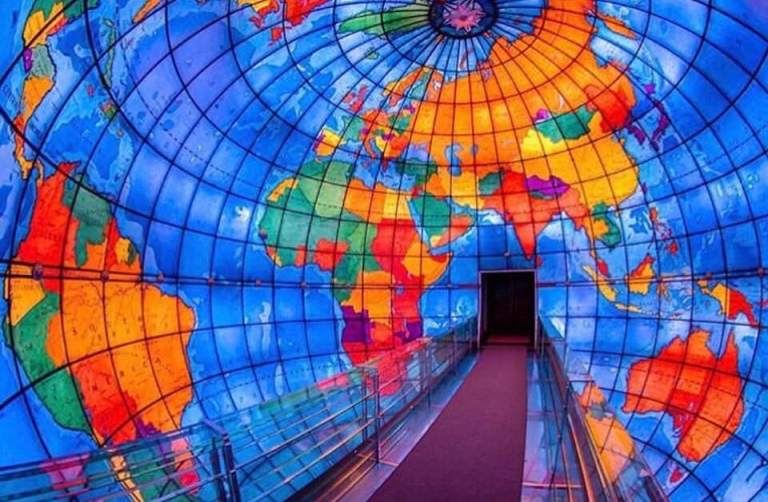The Mapparium: A View from the Heart of the World
Visitors to Boston walk the Freedom Trail, visit the Old North Church and our gilded State House, but we who live here are often the last to visit the treasures of our history. Included among them is The Mapparium at the Mary Baker Eddy Library, located in the Christian Science Center in Boston’s Back Bay district.
I’ve been aware of the Mapparium’s existence for decades, but for reasons unexplainable, I have never been to see it. Recently, we took our 9-year-old cousin on a tour for his birthday.
In the 1930s, a Boston architect, Chester Lindsay Churchill, designed the headquarters of the Christian Science Publishing Society. He included in his design a huge sphere three-stories high, with a 30-foot bridge running through its center—a “walk-in” representation of the globe. The gigantic sphere is made up of 608 meticulously glass-etched panels, shipped to Boston from England, that together form a stained-glass map of the world, using the geo-political boundaries as they were in the mid-1930s.
The lighting has been recently updated to integrate the most up-to-date technology, and a visit inside the massive globe includes a dramatic sound and light display showcasing voices of international heroes such as Nelson Mandela, Mahatma Gandhi, Eleanor Roosevelt, and Winston Churchill.
Before my trip, I thought it would be an intriguing visit to an historical oddity. But it turned out to be far more than that. In fact, standing on the bridge inside the sphere, looking at the world from where the earth’s molten center would be, was a deeply moving experience.
Perhaps it was the music, or the way the sphere amplifies sound. A whisper delivered at one end of the bridge reverberates sonorously to the other end of the giant globe.
Perhaps it was seeing the continents in relation to one another that revealed their proportionate size much more accurately than we perceive them on a flat wall map. For example, Africa is far bigger than we think it is, as is Australia.
Perhaps it was the novel view of where the continents are located in relation to the equator. From the bridge, one really has to stretch to see how far north Asia, Europe and the United States are. Or the sudden comprehension of spatial relationships around the globe. One recognizes why a plane flying from London to the west coast of America has to fly over Montana, Idaho, Oregon and Nevada.
But what most touched me was how much has changed in the world since the sphere was erected more than 80 years ago, and how much remains permanently unchangeable.
I found it fascinating that this globe was designed for permanence, as if the world of 1935 would remain static.
The Christian Science Church considered updating the map on several occasions, but each time they decided against it because it would be too costly. They also recognized that it has a special attraction as an historical artifact. Siam and Peking are frozen in glass. Africa is represented as a patchwork of colonies belonging to Britain, Portugal, Belgium, Germany, Italy, France and Spain. Rhodesia is now Zimbabwe. South Africa is forever memorialized as a Union, although it has been a Republic, independent from the British Commonwealth, since 1961. The Soviet Union is one massive political entity, having swallowed up the countries of Eastern Europe. Even in 1966, the last formal decision not to update the sphere, it was unimaginable that the USSR would collapse, and the countries of Eastern Europe might one day regain their independence.
The reality is that much has evolved since the sphere was built. New countries have emerged. Alliances that once seemed permanent have dissolved. But, while geo-political boundaries have shifted, the continents themselves remain unchanged. They are fixed in their relation to one another. And viewed from the beating heart of our world, a number of other things become eminently clear.
We are bound by our world to one another, and we are “bounded”—limited—to that world. From the inside of that sphere, it becomes crystal clear that we have nowhere else to go. When we stand on the outside—our view limited to the horizon—we can still imagine that the world is a vast place, bigger than we can understand or encompass. But, viewing the world from the inside, there is no horizon. We can see everything on our planet with a twist of the head, and our world is in no way boundless. We live on a miniscule marble hurtling through the infinity of space, and it is the only stability we have.
From this perspective, thinking of the challenges we face as a species and the cruelties we impose on each other, I was moved to tears. I found myself wondering what it would be like if there were a Mapparium in every major city in the world.
What if every schoolchild and every citizen were obliged to tour it once every few years, to be reminded how close we are to each other, how small our planet is, and how unchanging it is even as we redraw boundaries and give places new names. It might be one way to remind us all that this hurtling sphere is the only place we have to leave those who follow us.

